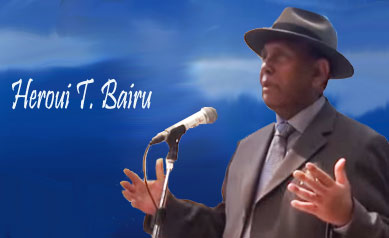The Refugee Act of 1980 and the Quiet Burial of the ELF

The U.S. Refugee Act of 1980 is occasionally invoked—most notably by Eritreans, and rarely in writing, and, at least, once in an Amharic-language book by Ethiopian politician and author Gebru Asrat (a page of which was translated for me)—as evidence of a deliberate American strategy to dismantle the Eritrean Liberation Front (ELF). These claims, though presented with conviction, rest on no direct evidence. They do not suggest the Act had unintended consequences; rather, they allege a calculated Cold War maneuver designed to neutralize the ELF, whose tens of thousands of fighters had withdrawn into Sudan.
However emotionally compelling to some, such a perspective falls short of the standards of historical evidence. It reflects a broader frustration among Eritreans, who often interpret U.S. actions through the prism of their political struggles—viewing foreign intervention as a recurring thread in their national experience. As the Tigrinya saying goes: “ሓንሳብ ብተመን ዝተነኽሰስ: ምራን ሪኡ ተዳህለ” “Once bitten by a snake, one is frightened by the sight of a rope.” This emotional attachment to the ELF’s legacy shapes how events are remembered and understood. While it is important to acknowledge the personal and political weight of such claims, we must also distinguish between emotional resonance and evidentiary rigor.
According to this view, the Act functioned as a geopolitical tool, targeting the ELF for its perceived ties to the Soviet bloc. Gebru and others maintain that resettling Eritrean refugees—especially ex-ELF fighters and organizers—was “the last nail in the coffin” of the movement. This interpretation, while compelling, lacks solid evidence. Scholars like Idean Salehyan have shown that U.S. refugee policy consistently operates under a dual logic—part humanitarian, part strategic. While suspicion of ulterior motives is reasonable, it does not constitute proof.
The Cold War Context: More Than Just the ELF
To assess the role of the Refugee Act, one must situate it within the broader Cold War context. U.S. refugee policy during that era was shaped primarily by opposition to communist regimes, with priority given to refugees from Cuba, Vietnam, and Soviet-bloc countries. Eritrean movements, by contrast, remained peripheral to American strategic interests. The U.S. largely regarded the ELF and EPLF as national liberation fronts, not as communist insurgencies. Its primary concern lay with Ethiopia’s Soviet-backed Derg regime. While Eritrean refugees were granted resettlement opportunities, there is no evidence to suggest this was part of a covert American strategy to undermine the ELF. That said, one is obliged to recall the cautionary adage: “absence of evidence is not evidence of absence.”
The Timing and Cause of the ELF’s Collapse
The Refugee Act was enacted in 1980, a full year before the collapse of the Eritrean Liberation Front (ELF) in 1981. Its timing and the ELF’s disintegration were coincidental, not causal. The demise of the ELF is more convincingly attributed to internal fragmentation and military defeat at the hands of the EPLF, which was bolstered by the TPLF. (Here lies the paradox of the EPLF: its relentless pursuit of victory often came at the expense of moral and principled restraint.) The ELF was plagued by political rivalries and factionalism, rendering it vulnerable to both internal discord and external pressure. This internal paralysis—rather than any external policy such as the Refugee Act—was the decisive factor in its decline.
Flaws in the ELF Collapse Claim
Gebru Asrat and others contend that the resettlement of former ELF fighters sealed the movement’s fate, but this claim seems to falter under closer scrutiny. The Refugee Act was enacted prior to the ELF’s collapse, making it chronologically irrelevant to the organization’s downfall. Moreover, the Act was global in scope, extending its provisions to refugees from Vietnam, Cuba, Ethiopia, Eritrea, and beyond—hardly a targeted intervention. Most critically, the ELF’s demise stemmed from internal fragmentation, military setbacks, and entrenched political rivalries, not from legislative resettlement policies.
The claim that the Refugee Act was a targeted instrument against the Eritrean Liberation Front (ELF) appears to conflate coincidence with causation. Assertions that the law directly contributed to the ELF’s collapse rest more on emotional conviction and speculative inference than on verifiable historical evidence. I would welcome any effort to prove otherwise—and it need not be difficult. Simply provide the evidence.
Internal Struggles Within the ELF
The ELF’s undoing stemmed from its own divisions. Factions within the ELF resisted reforms, and its base was shifting away from the Muslim-dominated leadership in Barka toward a more diverse, Christian, and highlander base. These divisions weakened the movement’s ability to adapt to changing political and military realities. The ELF’s failure to reform, coupled with external military defeats, sealed its fate. The EPLF and TPLF, which eventually succeeded in defeating the Derg, were more homogenous and better able to mobilize support.
The Role of the Refugee Act
While the Refugee Act was not intended as a tool to target the ELF, it did provide Eritreans with an opportunity to resettle in the U.S. Many Eritrean refugees were resettled from Sudan through UNHCR referrals, while others applied for asylum from various countries. This was possible because the U.S. viewed Eritrean movements as national liberation struggles, not as communist fronts. It is important to note that the law was not designed with Eritrea in mind, but because of its broad global application, Eritreans, like other refugees, benefited from the humanitarian provisions of the Act.
The Refugee Act and Its Operational Timeline
While the Refugee Act of 1980 was signed into law in April 1980, the actual registration, interviewing, and processing for Eritrean refugees did not begin till mid to late 1980. The first Eritrean refugees were processed and began arriving in the U.S. in early 1981. This process involved both refugees who had been living in Sudanese camps for years and those who applied for asylum from various countries. By early 1981, the first wave of resettled Eritrean refugees began arriving in the United States, a crucial moment for many who had spent years in limbo, fleeing conflict and repression.
Eyewitness Perspective: Tesfai Woldemichael (Degiga) and the ELF’s View of U.S. Policy
To better understand how the Refugee Act was perceived within the ELF, I reached out to Mr. Tesfai Woldemichael—widely known as Degiga—a former executive leader of the movement. His reflections offer a rare glimpse into the mindset of the ELF leadership during its formative years in exile, prior to the Rassai coup of March 25, 1982, which claimed the life of Melake Tekele and led to the imprisonment of Tesfai himself along with several senior leaders.
According to Mr. Tesfai, the prevailing perception among ELF leaders was that U.S. immigration policy toward Eritreans—particularly former fighters—was not neutral. Many believed it was a deliberate strategy to dismantle the ELF, rooted in the assumption that the organization was ideologically aligned with the Soviet Union. This belief was strong enough that the ELF dispatched cadres to campaign against the policy, viewing refugee resettlement as a direct threat to their political survival. The campaign had little impact.
At the time, the ELF leadership was actively preparing to return to Eritrea and reestablish its presence in Gash, Akeleguzay, and Dankalia—regions they regarded as their historical strongholds and comparatively secure. (Notably, Daniel Semere Tesfai—widely considered one of Eritrea’s finest novelists—argued in his seminal work, ሓላው ‘ታ ወርቃዊት ገረብ, that one of the ELF’s gravest strategic failures was its inability to recognize Dankalia, with its critical access to the outside world, as an existential lifeline for the movement’s survival.)
The resettlement of fighters to the West, especially to what were viewed as “imperialist countries,” was seen not only as a drain on their human capital but also as a challenge to their ideological integrity. There was internal debate about whether immigration to the U.S. and other Western nations was even appropriate for Eritreans, given the movement’s anti-imperialist stance.
Yet despite the intensity of these concerns, Mr. Tesfai candidly acknowledged that he was not aware of any concrete evidence linking U.S. immigration policy to a deliberate effort to neutralize the ELF. The perception was widespread and deeply felt, but it remained speculative. His admission underscores the distinction between political belief and historical proof—a distinction that is crucial when evaluating claims about the Refugee Act’s impact.
U.S. Refugee Policy: A Humanitarian Law Born of Crisis
The Refugee Act was born out of the global humanitarian crisis following the Vietnam War. It sought to formalize U.S. refugee admissions, moving away from Cold War biases and establishing a race-neutral system for refugees. The law was part of a broader global response, particularly focused on Southeast Asia, and was not targeted at specific regions or movements. While Eritreans benefited from the law, it was not written with their specific needs in mind.
The Persistence of Eritrean Claims and the Need for a Broader Understanding
The claim that the Refugee Act sealed the ELF’s fate persists in part because of the historical and emotional lens through which many Eritreans view their struggle for independence. For some, the resettlement of refugees represents a betrayal by the West, reinforcing a narrative of abandonment. However, this view overlooks the complex and multifaceted reasons for the ELF’s decline. As Eritrean history has evolved, so too has its relationship with the U.S. While the regime in Eritrea has made it difficult for Eritrean-Americans to have a meaningful influence on U.S. foreign policy, the current political situation in Eritrea is a product of internal factors, including authoritarian rule and human rights violations, rather than external conspiracy.
Setting the Record Straight
The Refugee Act of 1980 was a humanitarian reform, created to address a global crisis, not a tool to dismantle the ELF. Eritrean refugees benefited from this law because the U.S. saw their struggle as a national liberation movement, not a communist insurgency. The ELF’s collapse was primarily the result of internal fragmentation, military defeat, and failure to adapt to the changing political landscape of the Horn of Africa. Gebru Asrat’s argument that refugee resettlement was “the last nail in the coffin” of the ELF does not withstand scrutiny. Instead, the movement’s decline was driven by its internal divisions and external military defeats.
Today, some Eritrean officials are denied asylum not due to ideological labels like communism or terrorism, but because of their alleged involvement in a repressive regime and credible charges of human rights violations. Immigration judges rule on individual cases, weighing evidence and testimony, which reflects personal accountability, not Cold War geopolitics or the War on Terror. The claim that the Refugee Act was a deliberate tool to dismantle the ELF is unproven. Correlation is not causation, and inference is not evidence.
Conclusion: The Role of History in Shaping Political Narratives
The claim that the U.S. Refugee Act of 1980 was a deliberate strategy to dismantle the ELF is rooted in the political and emotional context of the Eritrean struggle for independence. However, as this essay has shown, the law was a humanitarian measure born out of a global refugee crisis, not a calculated move against the ELF. To understand the collapse of the ELF, we must look beyond external interventions and focus on the internal divisions that weakened the movement.
Eyewitness accounts—such as those from Mr. Tesfai Woldemichael (Degiga)—reveal how deeply the ELF leadership internalized Cold War anxieties, often interpreting refugee resettlement as an existential threat. Yet even these politically charged perspectives, while invaluable, fall short of providing concrete evidence. They reflect a perception shaped by ideological struggle and strategic uncertainty, not a documented conspiracy. (Tesfai remains a credible and generous witness—always a joy to speak with and learn from. I understand that his priority is to complete the “unfinished revolution” to which he has devoted his life. Still, I can’t be faulted for hoping he will one day honor us with his memoir. He has seen it all.)
In reassessing these narratives, we do not diminish the sacrifices of those who fought for Eritrea’s liberation. Rather, we honor them by seeking truth over myth, and by grounding our understanding in historical complexity rather than emotional inference. The quiet burial of the ELF was not orchestrated from Washington—it was the result of internal fragmentation, shifting alliances, and the unforgiving terrain of revolutionary politics.
As Eritreans continue to wrestle with the legacy of liberation and the burdens of authoritarian rule, it is essential that historical memory remain clear-eyed and evidence-based. Only then can future generations build a political culture rooted not in grievance and suspicion, but in accountability, resilience, and truth.



Awate Forum